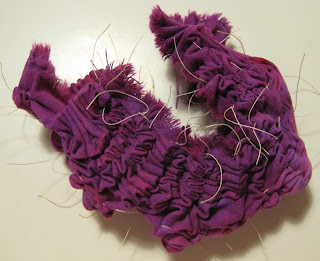This summer I’ve spent a lot of time decluttering my home and getting rid of stuff that I’ve collected over the years. Yesterday I found yet another place where I’d hidden away a bunch of papers that needed to be sorted out. I’m more and more convinced that I was a squirrel in an earlier life.
While sorting out the cupboard where I mainly keep my craft supplies, I found a small box with bits of wool that were the leftovers from a rather ambitious slipover project that I knitted some years ago. The yarn was so beautiful that I hadn’t had the heart to throw it away. In the same box I also found snippets of machine embroidery thread that I had saved ‘for something’. While pondering whether to throw away or save these treasures, I decided on a third option: to make them into something right away.
A number of years ago I experimented a bit with combining yarn and machine embroidery. My first experiment was inspired by a Swedish textile artist, AnnLis Krüger, who uses yarn in her humorous art quilts. Her technique was to wind a bit of yarn around her fingers, place it on a piece of fabric and free-motion stitch it in place. I tried this method, thought it was fun, but a bit tricky, as you had to watch your fingers carefully and be on the alert for loops that got caught around the embroidery foot. Here’s little quilt I made with this technique:
My next experiment was to loosely knit a piece of fabric, place it between two sheets of water-soluble stabiliser and free-motion stitch the surface to flatten the fabric and lock the knitted stitches in place. That was a lot safer for the fingers and there was no risk of the foot getting stuck on loops. This is what the knitted and stitched fabric looks like:
The embellishers/needle-felting machines that are on the market now open up the possibilities for combining yarn and fabric further. When I did my earlier experiments, I’d hardly even heard of needle-felting, let alone of any needle-felting machines for domestic use. I don’t think that I will invest in an embellisher, but I have bought a handy little tool that is a kind of hand-driven mini needle-felting machine:
So when I found that leftover yarn, I decided it was time to put the needle-felting gadget to the test. I used a piece of craft felt as the base, put a generous amount of fibres (yarn and machine embroidery thread) on top and started punching away. It took me a quite a while to punch the fibres in place (a machine would definitely be a lot quicker), but as long as the project is small and you are equipped with a bit of patience it’s doable. When the fibres were relatively well attached, I took the fabric over to the sewing machine and free-motioned on top to secure everything in place.
I then took my needle-felted fabric pieces and made them into these cute little hearts:
I’d be happy to post instructions on how to make these hearts if anyone is interested. Just leave a comment or e-mail me, and I’ll include the instructions in a future blog post.



















